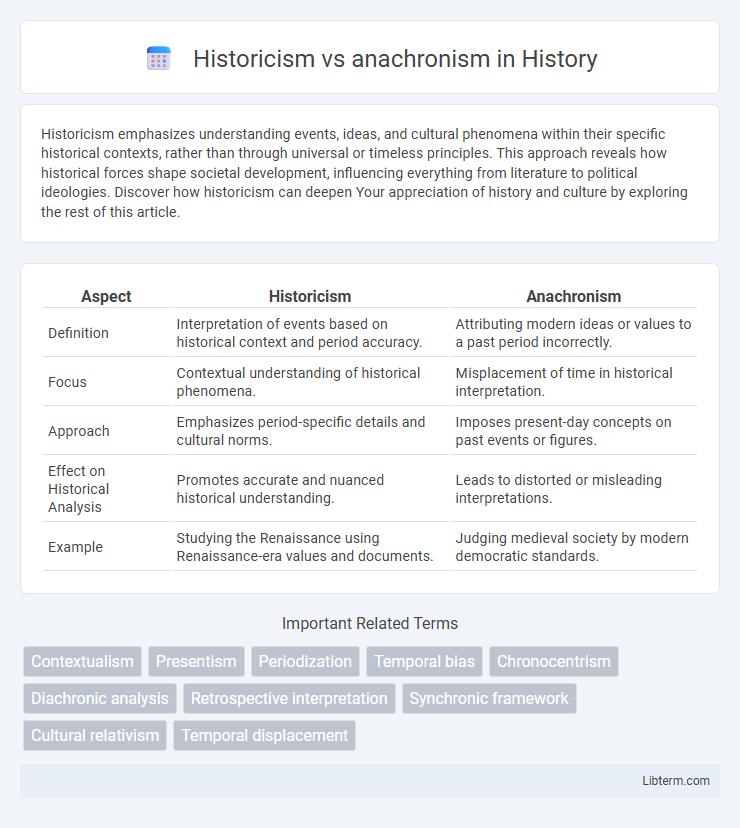Historicism emphasizes understanding events, ideas, and cultural phenomena within their specific historical contexts, rather than through universal or timeless principles. This approach reveals how historical forces shape societal development, influencing everything from literature to political ideologies. Discover how historicism can deepen Your appreciation of history and culture by exploring the rest of this article.
Table of Comparison
| Aspect | Historicism | Anachronism |
|---|---|---|
| Definition | Interpretation of events based on historical context and period accuracy. | Attributing modern ideas or values to a past period incorrectly. |
| Focus | Contextual understanding of historical phenomena. | Misplacement of time in historical interpretation. |
| Approach | Emphasizes period-specific details and cultural norms. | Imposes present-day concepts on past events or figures. |
| Effect on Historical Analysis | Promotes accurate and nuanced historical understanding. | Leads to distorted or misleading interpretations. |
| Example | Studying the Renaissance using Renaissance-era values and documents. | Judging medieval society by modern democratic standards. |
Introduction to Historicism and Anachronism
Historicism emphasizes understanding historical events, ideas, and cultural contexts within their specific timeframes, avoiding present-day biases in interpretation. Anachronism occurs when contemporary concepts or values are mistakenly applied to past events, leading to distorted understandings. Analyzing texts or artifacts through historicism reveals the authentic mindset of historical periods, while identifying anachronisms highlights misinterpretations in historical analysis.
Defining Historicism: Contextual Understanding
Historicism emphasizes interpreting historical events, ideas, and artifacts within their original social, cultural, and temporal contexts to avoid distorting their meanings. It prioritizes understanding the specific conditions and values influencing past phenomena, ensuring accurate representation free from present-day biases. This contextual approach contrasts sharply with anachronism, which imposes contemporary perspectives or values onto historical subjects, often leading to misinterpretation.
Understanding Anachronism: Meaning and Examples
Anachronism refers to the misplacement of events, objects, or customs in a historical context where they do not belong, often distorting the accuracy of historical interpretation. Understanding anachronism involves recognizing examples such as depicting modern technology in ancient settings or attributing contemporary social values to past societies, which can lead to misconceptions about historical realities. Distinguishing anachronism from historicism, which emphasizes contextual accuracy and period-specific understanding, is crucial for rigorous historical analysis.
Origins and Evolution of Historicism
Historicism originated in the 19th century as a critical framework emphasizing the importance of understanding historical events, texts, and cultural phenomena within their specific temporal contexts. This approach evolved through the contributions of scholars like Leopold von Ranke, who advocated for sourcing history from primary documents to reconstruct the past accurately. Over time, historicism expanded to influence various disciplines, arguing against anachronism by rejecting the imposition of present-day values or perspectives on historical analysis.
Common Types and Sources of Anachronism
Historicism emphasizes understanding historical events within their original context, while anachronism involves attributing modern concepts or perspectives to past periods inaccurately. Common types of anachronism include chronological errors, such as placing technology or ideas in the wrong era, and cultural anachronisms, where contemporary values are imposed on historical figures. Sources of anachronism often stem from limited historical knowledge, presentism, or the desire to relate past events to current understandings.
The Importance of Context in Historical Interpretation
Understanding historicism requires analyzing events, texts, and ideas strictly within their original temporal and cultural contexts, avoiding the imposition of present-day values or perspectives. Anachronism distorts historical interpretation by projecting modern beliefs onto past phenomena, leading to misrepresentation and oversimplification. Accurate historical analysis hinges on contextualizing evidence to preserve its intended meaning and reveal authentic insights into the period under study.
Historicism in Literature, Art, and Historiography
Historicism in literature, art, and historiography emphasizes interpreting works and events within their specific historical context, acknowledging the influence of cultural, social, and political factors of the time. This approach contrasts with anachronism by resisting the imposition of contemporary values or perspectives on past periods, thereby preserving authenticity and accuracy in representation. In art and literature, historicism promotes understanding styles and themes as products of their era, while in historiography it fosters critical analysis based on period-specific evidence and contexts.
Consequences of Anachronism in Historical Analysis
Anachronism in historical analysis distorts understanding by imposing present-day values, concepts, or interpretations onto past events, leading to inaccurate conclusions. This temporal misplacement undermines the authenticity of historical context, resulting in biased interpretations and misrepresentation of historical actors and their motivations. Such consequences hinder scholars' ability to objectively reconstruct history and obstruct the development of sound historiographical methodologies.
Strategies to Avoid Anachronistic Fallacies
Strategies to avoid anachronistic fallacies include rigorous contextual analysis of historical sources, ensuring interpretations align with the social, cultural, and technological realities of the period studied. Employing primary documents and contemporaneous perspectives helps maintain accuracy by grounding understanding in the original historical framework. Cross-disciplinary methodologies and critical examination of presentist biases further safeguard against projecting modern values or knowledge onto historical events.
Conclusion: Balancing Historicism and Critical Inquiry
Balancing historicism and critical inquiry requires recognizing the importance of understanding historical context while applying rigorous analysis to avoid anachronistic interpretations. Effective scholarship integrates empathy for past societies' values with contemporary perspectives, fostering nuanced conclusions. This approach enriches historical study by ensuring accuracy and relevance without distorting original meanings.
Historicism Infographic

 libterm.com
libterm.com